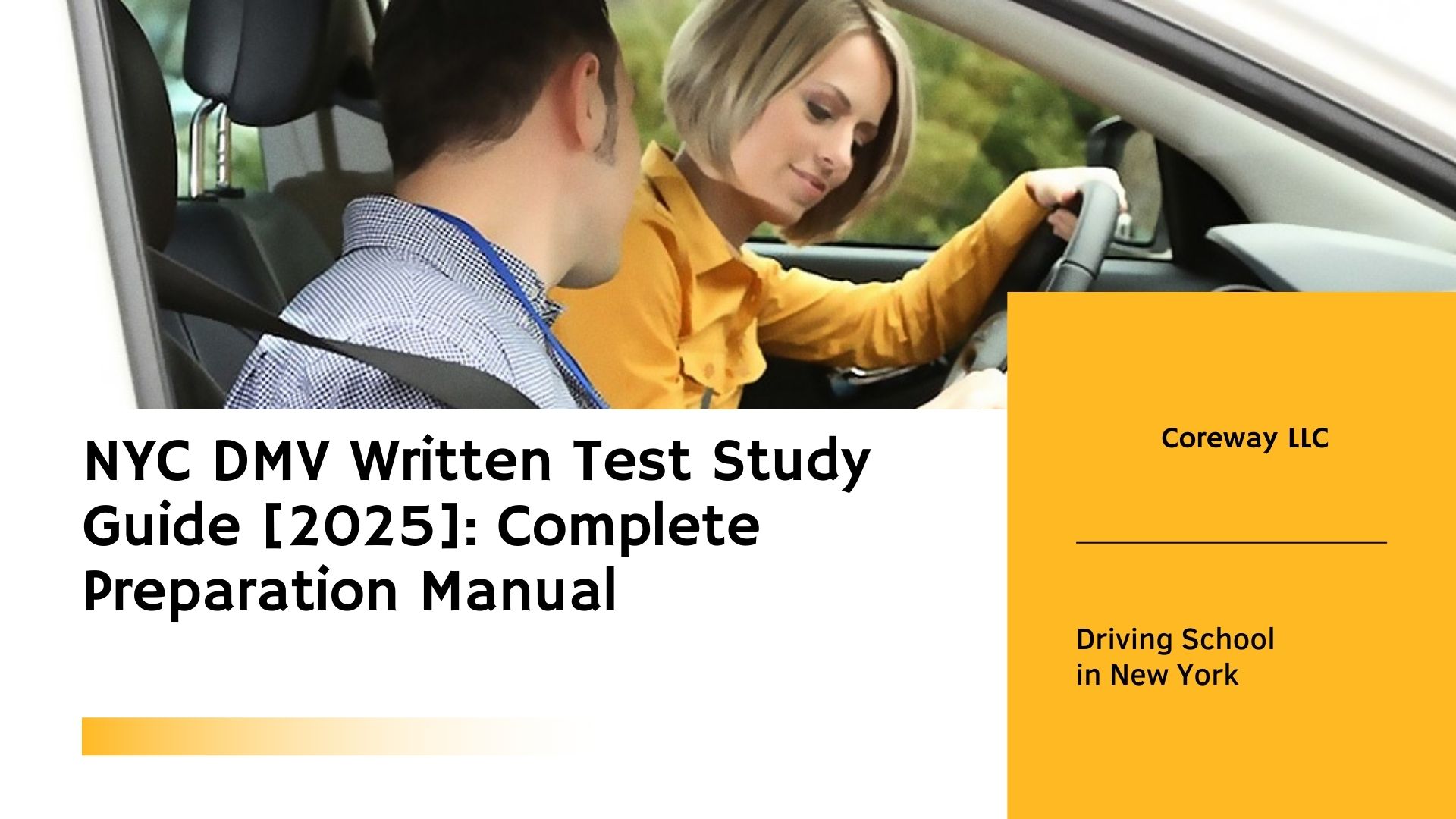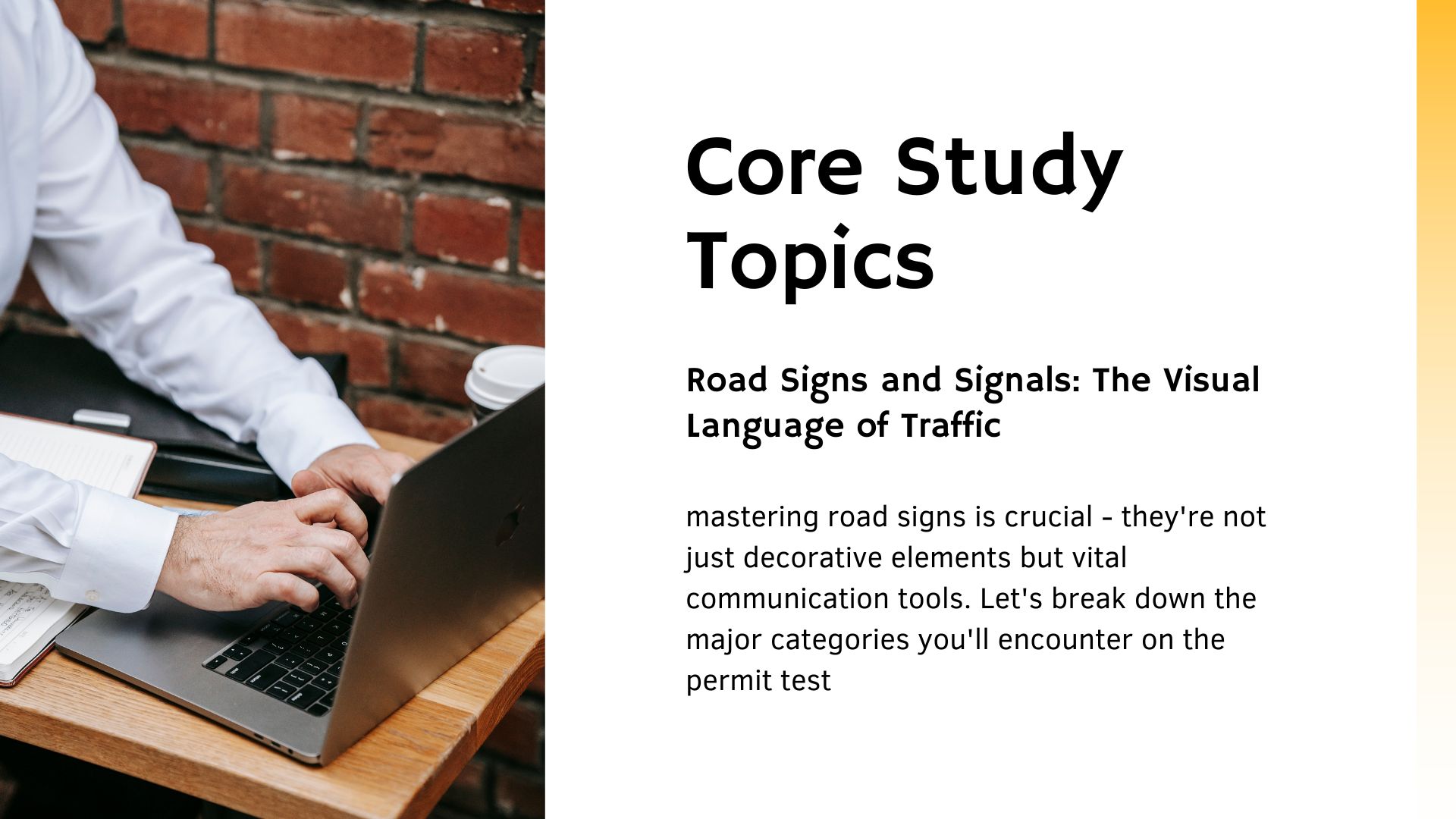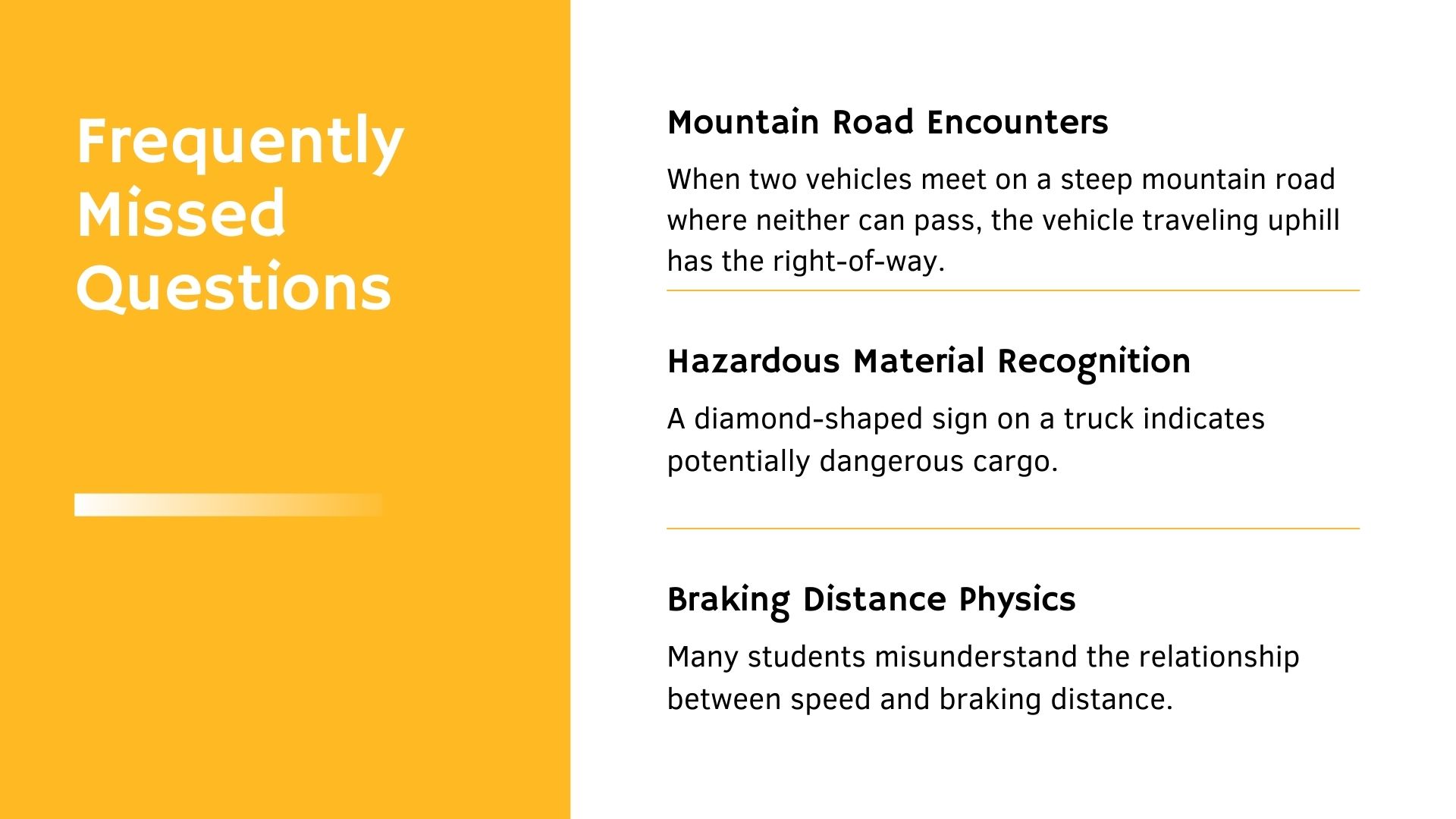NYC DMV Written Test Study Guide [2025]: Complete Preparation Manual

Table of Contents
Getting ready for your DMV written test in New York City doesn't have to be overwhelming. As a driving instructor with over a decade of experience helping students ace their permit tests, I've developed this comprehensive guide to streamline your preparation process. Whether you're a first-time driver or new to the state, this resource covers everything you need to know about the NY permit test.
The New York State permit test consists of 20 multiple-choice questions, and you'll need to answer at least 14 correctly (70%) to pass. The questions cover traffic laws, road signs, and safe driving practices specific to NY state regulations. In 2025, the NYC metropolitan area maintains a pass rate of approximately 65% for first-time test takers, highlighting the importance of thorough preparation.
Test locations throughout the five boroughs offer the exam in multiple languages, including:
- English
- Spanish
- Chinese (Traditional and Simplified)
- Russian
- Korean
- Arabic
Essential Documents & Fees
Before heading to the DMV, ensure you have all required documentation to avoid multiple trips. Here's a comprehensive checklist:
Required Documentation Checklist
|
Document Type |
Details |
Notes |
|
Form MV-44 |
Driver's License Application |
Can be pre-filled online |
|
Social Security Card |
Original document required |
No photocopies accepted |
|
Form MV-619 |
Vision Test Certification |
Optional if testing at DMV |
|
Form MV-285 |
Driver's Education Certificate |
If completed approved course |
|
Identity Documents |
Must total 6 points |
At least one with birth date |
2025 Fee Structure for NYC Metropolitan Area
The Metropolitan Commuter Transportation District (MCTD) has specific fee requirements based on age:
|
Age Group |
Standard Fee |
MCTD Fee |
|
16-16.5 |
$80.00 |
$90.00 |
|
16.5-17 |
$76.50 |
$85.75 |
|
17-17.5 |
$92.50 |
$102.50 |
|
17.5-18 |
$89.25 |
$98.25 |
|
18-21 |
$76.75-$80.00 |
$85.75-$90.00 |
|
21+ |
$64.25-$67.50 |
$73.25-$77.50 |
Pro Tip: The DMV accepts credit cards, debit cards, checks, and money orders. Cash payments are not accepted at most locations for security reasons.
Test Format and Structure
Understanding the test structure can significantly boost your confidence on exam day. The computerized testing system presents questions in a random order, covering these key areas:
- Traffic signs and signals (25% of questions)
- Road rules and regulations (35%)
- Safe driving practices (25%)
- Alcohol and drug laws (15%)
You'll have 20 minutes to complete the test, though most candidates finish within 10-15 minutes. Each question provides four possible answers, and while some may seem obvious, others require careful consideration of New York's specific traffic laws.
Testing centers use modern touchscreen systems, making navigation intuitive even for those less comfortable with computers. The interface allows you to mark questions for review and return to them before final submission.
Key Testing Features:
- Instant results upon completion
- Option to flag questions for review
- Clear progress indicator
- Available audio assistance if needed
- Zoom functionality for visually impaired
Call Us Today 9AM-10PM
Or fill out the form 24/7
Our team is here to guide you with promotions, instructor availability, and the best training package for you.
Core Study Topics

During my years as a driving instructor, I've noticed that students who master the core subjects rarely need multiple attempts to pass their permit test. The New York DMV consistently focuses on specific areas that directly impact road safety. We'll dive deep into each topic, starting with the visual elements that guide every driver's decisions. Understanding these fundamentals will not only help you pass the test but also make you a more confident driver from day one.
Road Signs and Signals: The Visual Language of Traffic
mastering road signs is crucial - they're not just decorative elements but vital communication tools. Let's break down the major categories you'll encounter on the permit test:
Warning Signs (Yellow)
- Diamond-shaped for advance warning
- Pedestrian crossings
- Merging traffic patterns
- School zones
- Construction areas
- Weather-related hazards
Regulatory Signs (Red and White)
- Stop and yield requirements
- Speed limit zones
- Turn restrictions
- Parking regulations
- One-way street indicators
Guide Signs (Green)
- Highway exits
- Street names
- Mile markers
- Destination directions
- Service information
Pro Tip: Don't just memorize sign shapes and colors. Understanding the logic behind sign placement and design will help you answer situational questions more effectively.
Traffic Laws and Rules: The Foundation of Safe Driving
New York's traffic regulations form the backbone of the written test. Here are the most tested topics:
Right-of-Way Rules
Understanding right-of-way isn't just about test success - it's about preventing accidents. Key scenarios include:
- Emergency vehicle approaches
- Pedestrian crossings
- Uncontrolled intersections
- Multi-way stop signs
- Roundabouts and traffic circles
Speed Management Guidelines
|
Zone Type |
Speed Limit |
Special Considerations |
|
School Zones |
15-25 mph |
Active during school hours |
|
Residential |
25-30 mph |
Watch for children and pets |
|
Business Districts |
25-35 mph |
Heavy pedestrian traffic |
|
Highways |
55-65 mph |
Weather adjustments needed |
Parking Regulations
The test often includes questions about proper parking techniques:
Mountain Road Parking
- Uphill with curb: Turn wheels left
- Uphill without curb: Turn wheels right
- Downhill: Always turn wheels right
Safe Driving Practices: Beyond the Basics
After years of teaching, I've noticed that questions about safe driving practices often trip up test-takers. Here's what you need to focus on:
Following Distance Rules
- 3-second rule in ideal conditions
- 4+ seconds in adverse weather
- Double distance at night
- Triple distance on highways
Weather Condition Adjustments
Modify your driving behavior based on conditions:
|
Weather Condition |
Speed Reduction |
Additional Measures |
|
Light Rain |
5-10 mph |
Increase following distance |
|
Heavy Rain |
15-20 mph |
Use wipers and lights |
|
Snow |
25-30 mph |
Avoid sudden movements |
|
Ice |
50% or more |
Maximum caution needed |
Night Driving Protocols
The permit test includes several questions about night driving safety:
- High beam usage and switching
- Increased following distance
- Proper use of reflectors
- Vision accommodation techniques
Each of these topics requires specific attention during your study sessions. Remember, the test isn't just about memorizing facts - it's about understanding how these elements work together to create a safe driving environment.
Critical Test Topics
Let me share a crucial insight from my experience: nearly 40% of permit test failures stem from misunderstanding vehicle control and impaired driving questions. While road signs and basic rules form the foundation, these advanced topics often determine whether you'll pass or need a retake. The DMV intentionally includes these questions because they directly relate to life-saving decisions on the road. Pay special attention to the following sections – they're not just test material, but essential knowledge that every New York driver must understand.
Vehicle Control and Handling
Mastering vehicle control concepts is essential not just for passing your permit test, but for becoming a competent driver. Let's examine the key areas that frequently appear on the exam:
Brake System Operations
Modern vehicles come with different braking systems, and understanding their operation is crucial:
Anti-Lock Braking System (ABS):
- Maintain firm, continuous pressure
- Don't pump the brakes
- Allow for normal pedal vibration
- Maintain steering control
Traditional Brakes:
- Pump brakes on slippery surfaces
- Apply gentle, steady pressure
- Watch for skidding indicators
- Release pressure if wheels lock
Emergency Maneuvers
The test often includes questions about handling critical situations:
|
Scenario |
Primary Action |
Secondary Steps |
|
Head-on Collision Threat |
Slow down, move right |
Sound horn, flash lights |
|
Brake Failure |
Pump brakes, downshift |
Use emergency brake gradually |
|
Tire Blowout |
Grip wheel firmly, ease off gas |
Coast to safe area |
|
Skidding |
Steer into skid direction |
Avoid sudden braking |
Impaired Driving Laws
New York maintains strict regulations regarding impaired driving, and you'll need to know these details for your test:
Blood Alcohol Concentration (BAC) Limits
|
Driver Category |
Legal Limit |
Zero Tolerance |
|
Regular License |
0.08% |
N/A |
|
Commercial |
0.04% |
N/A |
|
Under 21 |
0.02% |
Yes |
Important Notes:
- Effects begin at 0.05% BAC
- Commercial limits apply while operating
- Zero tolerance laws affect drivers under 21
Chemical Test Refusal Consequences
Refusing a chemical test in New York carries serious penalties:
- First refusal: 1-year license revocation
- Second refusal: 18-month revocation
- Civil penalty of $500
- Mandatory DMV hearing
Prescription Medication Guidelines
The test includes questions about medication-related impairment:
- Check warning labels carefully
- Consult healthcare providers
- Never mix with alcohol
- Report certain medications to DMV
Real-World Application Scenarios
From my experience teaching thousands of students, these concepts often appear in situational questions. Here's a common example:
You're approaching a steep hill with a single lane, and another vehicle is coming downhill. Who has the right of way?
A: The vehicle traveling uphill has the right of way because:
- Maintaining uphill momentum is crucial
- Downhill vehicle has better control
- Backing downhill is safer than uphill
Pro Tip: When studying these topics, create mental connections between rules and real-world situations. This approach helps you understand the logic behind the laws rather than just memorizing facts.
Call Us Today 9AM-10PM
Or fill out the form 24/7
Our team is here to guide you with promotions, instructor availability, and the best training package for you.
Frequently Missed Questions

Drawing from years of experience preparing students for their permit tests, these questions consistently challenge test-takers. Let's break down each scenario with detailed explanations.
Mountain Road Encounters
When two vehicles meet on a steep mountain road where neither can pass, the vehicle traveling uphill has the right-of-way. This rule exists because vehicles traveling uphill need to maintain momentum and have more difficulty backing up safely. The downhill driver should find a wider section of road to pull over when possible.
Hazardous Material Recognition
A diamond-shaped sign on a truck indicates potentially dangerous cargo. These placards use specific colors and numbers to identify the type of hazard, though for your permit test, simply recognizing the diamond shape as indicating hazardous materials is sufficient.
Braking Distance Physics
Many students misunderstand the relationship between speed and braking distance. When you double your speed, the braking distance increases by four times, not just double. This exponential relationship explains why maintaining safe speeds is crucial, especially in adverse conditions.
Emergency Vehicle Protocol
You must yield to emergency vehicles using sirens or flashing red, blue, or white lights. The correct action involves pulling as far to the right as possible and stopping until the emergency vehicle passes. This applies even if you have a green light at an intersection.
Proper Steering Wheel Distance
The optimal distance between your chest and the steering wheel should be 10-12 inches. This spacing provides the best combination of control and safety, allowing airbags to deploy properly while maintaining comfortable reach to the pedals and controls.
Freeway Entrance Procedures
When entering a freeway from an acceleration lane, match your speed to the flow of traffic before merging. A common misconception leads some drivers to believe they should enter at a slower speed, which actually creates dangerous situations and disrupts traffic flow.
Anti-lock Brake Operation
During anti-lock brake engagement, maintain firm, continuous pressure on the brake pedal. Many test-takers incorrectly believe they should pump ABS brakes, which actually reduces their effectiveness. The pulsing sensation you feel is the system working correctly.
Parking on Hills
The proper direction to turn your wheels when parking depends on whether you're facing uphill or downhill and if there's a curb. When parking uphill with a curb, turn wheels away from the curb. When parking downhill, always turn wheels toward the curb. This prevents your vehicle from rolling into traffic if the brakes fail.
Horn Usage Guidelines
Your horn should only be used to warn others of immediate danger. Using it to express frustration, hurry other drivers, or attempt to get someone's attention while driving is not only incorrect but may also be illegal in certain situations.
Blood Alcohol Content Facts
A critical concept often tested concerns alcohol metabolism rates. An average 140-pound woman typically becomes legally intoxicated after three drinks, while an average 180-pound man reaches the limit after four drinks. However, the safest approach is not to drive after consuming any amount of alcohol.
Test Day Preparation
Physical Readiness
Start your test day right by getting 7-9 hours of sleep the night before. Eat a light but nutritious breakfast, and stay hydrated. Arrive at the DMV at least 30 minutes before your scheduled time to complete any last-minute paperwork without rushing.
Mental Preparation
Your mindset significantly impacts test performance. Stay calm by reminding yourself that you've prepared thoroughly. If you don't pass on your first attempt, you can retake the test after 24 hours.
Essential Test-Taking Strategies
Read every question twice before selecting an answer. The DMV intentionally includes similar-sounding options, so attention to detail matters. When uncertain between two answers, your first instinct is usually correct.
Time management tip: Start with questions you're confident about, then return to challenging ones. You'll have 20 minutes to complete 20 questions - plenty of time if you stay focused.
Quick Tips for Success
- Bring all required documents in a folder for easy access
- Use the restroom before starting the test
- Turn off your phone to avoid distractions
- Ask for clarification if a question seems unclear
- Review your answers if time permits
Post-Test Steps
Your next steps depend on your test results. Upon passing, you'll receive a temporary learner permit. If you don't pass, schedule a retake for the following day and focus on studying the topics that challenged you.
Schedule your road test appointment immediately after receiving your permit. Most NYC locations have a 2-3 week waiting period, so booking early ensures you maintain momentum in your licensing journey.
Call Us Today 9AM-10PM
Or fill out the form 24/7
Our team is here to guide you with promotions, instructor availability, and the best training package for you.
Frequently Asked Questions
-
How many times can I take the permit test if I fail?
You can retake the permit test as many times as needed, with a mandatory 24-hour waiting period between attempts. Each retake requires paying the testing fee again. We recommend using this time to focus on the specific areas where you struggled during your previous attempt.
-
Can I use my permit to practice driving immediately after passing the test?
Before driving with your permit, you must be accompanied by a licensed driver age 21 or older who has a valid New York State license. The supervising driver must sit in the front seat and be capable of taking control of the vehicle if necessary. Remember that certain restrictions apply during your first few months of supervised driving.
-
What happens if I forget to bring one of the required documents?
Unfortunately, the DMV cannot process your application or allow you to take the test without all required documents. Each document contributes to your mandatory 6-point ID verification. You'll need to reschedule your appointment and return with complete documentation.
-
How long is my learner's permit valid?
Your New York learner's permit remains valid for five years from the date of issue. However, you should aim to complete your road test and obtain your full license within the first year to maintain your driving skills and knowledge.
-
Do I need to memorize all traffic signs for the test?
The test requires understanding the meaning and appropriate responses to common traffic signs rather than pure memorization. Focus on comprehending the shape, color, and purpose of signs, as questions typically present realistic driving scenarios where you must apply this knowledge.
 English
English Spanish
Spanish 

